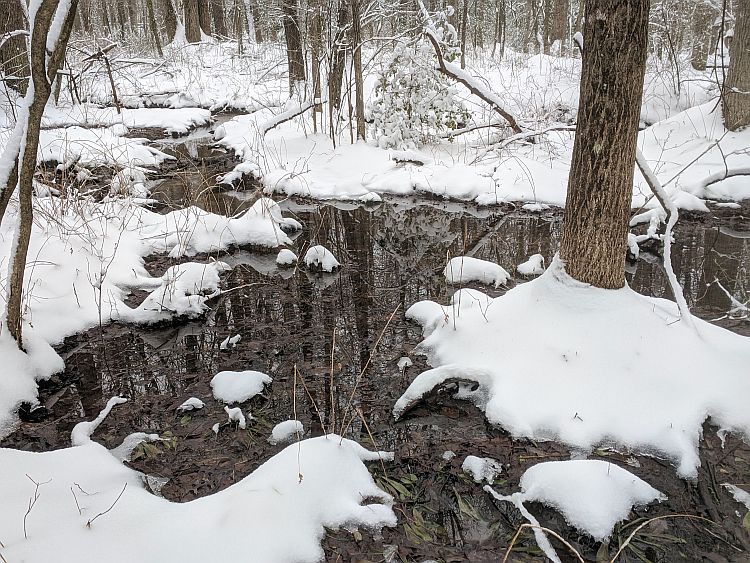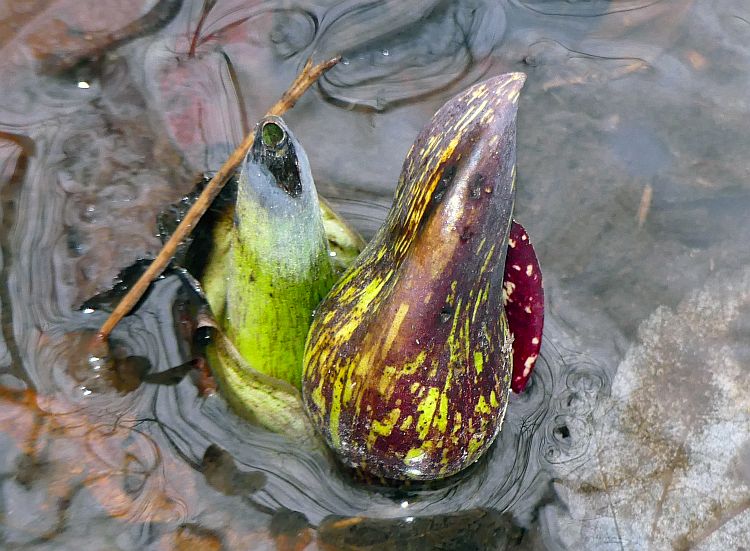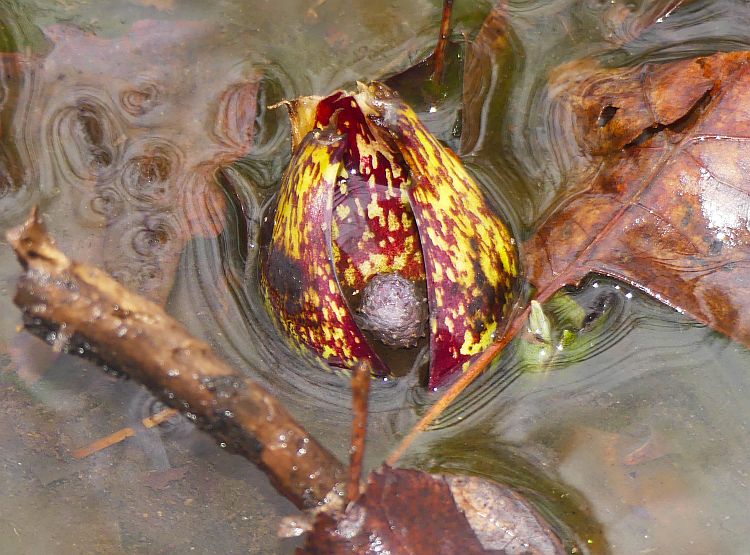Skunk Cabbage Secrets
By Nancy Sorrells
On this winter weather Valentine’s Day I decided to journey back into the forest behind our property to the secret place I know where the globally rare Swamp Pink (Helonias bullata) grows. Today’s visit was not to see Swamp Pink, which is still sleeping and will not send up its amazing pink globe-like blooms until April.
Rather, today’s trip was to see if I could find Skunk Cabbage (Symplocarpus foetidus) in bloom, the Society’s 2009 Wildflower of the Year.
Skunk Cabbage is not globally rare, but it is a companion to the Swamp Pink in my secret wetland. Technically, I guess the area is a fen, as it is a saturated area between the braided courses of a small, unnamed stream. Sometimes in the summer this stream is almost dry and other times, like today, there are fast flowing rivulets crisscrossing through the swale. The conditions across the acidic soils where the earth is sometimes saturated and sometimes dry, are the perfect environment for plants like Skunk Cabbage and Swamp Pink. Skunk Cabbage, however, is far less choosy and thus its large cabbage-like (and somewhat stinky) leaves are found across many types of wet and boggy areas.
However, as common as Skunk Cabbage is, it has a secret part of its life that people rarely see. Many folks have seen its expansive bright green leaves, but this time of year it does not look like that. In fact, there are no leaves yet, but this is the time of year that it blooms. Yes, it pokes up a prehistoric looking hood that is purple and green (called a spathe). In the center of the hood is a roundish, coronavirus-looking ball called a spadix.
As weird as all that is, it gets even weirder — this “flower” produces heat. Experts say it can warm up to 70 degrees F, so that even if it is blooming in February, it can reveal itself to pollinators by melting the snow and ice around it.
In the four inches of snow and ice that are now on the ground, I set off to my secret place to see if the Skunk Cabbage was in bloom. While I have been visiting the blooming Swamp Pink for 25 years or more, I have never visited the blooming Skunk Cabbage. Every year when I think about it, it is too late and I say “maybe next year.” Therefore, I crunched off through the snow and found my hidden swale. I noticed that there was a lot of water and all the stream rivulets were gurgling loudly and running swiftly. The water was running dark and clear with the brown rotting leaves providing a sharp contrast to the white blanket of snow that rounded off and softened all the sharp angles of sticks and rocks and other plants.
I crossed a couple of stream courses and made my way to the hummock in the middle where I knew the plants were hidden under the snow. All was quiet except for the crunching of snow and ice under my feet and the whole panorama in front of me looked pristine and beautiful. I spent about 20 minutes walking around, taking in the scene, and looking for melting circles around blooming Skunk Cabbage.
Try as I might, I could not find any melted circles with that purple and green hood poking up. I was just about to give up when I glanced over at a slower part of the stream flowing across an area that is normally boggy but not underwater. There they were — a couple of Skunk Cabbages poking up through the water rather than the snow. Right next to them and also inundated with water were the limp and battered leaves from last year’s Swamp Pink leaves with water flowing over top of them. I squished to the water’s edge, bent low and snapped away with the camera taking pictures of the Skunk Cabbage bloom.
On this day, the blooms were not melting snow, they were treading water.
Mission accomplished, I walked back through the woods and through the yard snapping a few more photos of the beautiful stream, the woods, and the patterns of snow, ice, and winter plants that Mother Nature had painted on her canvas.
All photos by Nancy Sorrells




Thank you. Beautiful colors.
Nancy please tell us what this amazing flower attracts for pollinators?
I found one of these in a state park right in the middle of the footpath and was absolutely mesmerized. I took a bunch of photos while everyone I was hiking with tried to disassociate themselves from my nerdiness haha. Thank you for telling me what it is! I finally have an ID 🙂
Fantastic post; I thoroughly enjoyed it and the great photos. Skunk cabbage… new to me! Thank you so much!